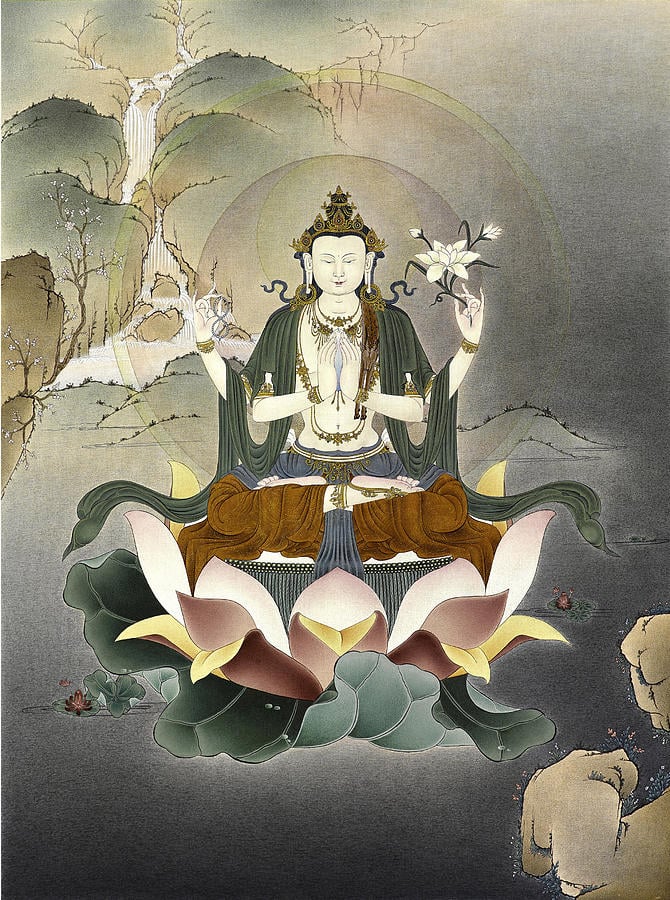Anapanasati Sutta is the heart of Satipatthana, the heart of all four foundations of mindfulness. The Anapanasati Sutta is a discourse (sutta) that details the Buddha’s instruction on using the breath (anapana) as a focus for mindfulness (sati) meditation. Probably no practice of Buddhism is more basic or more universal than anapanasati, or mindfulness of breathing. Anapanasati is a core meditation practice in Buddhism, as well as in many ancient Indian meditation teachings. This sutta and the Mahāsatipaṭṭhāna Sutta constitute the basics of vipassana/mindfulness meditation.
The Anapanasati Sutta is part of the collection of middle length discourses, the Majjhima-nikaya, of the Pali preserved by Theravada tradition. The discourses now found in the Pali canon are the final result of centuries of oral transmission of the texts believed to have been spoken originally by the Buddha and his disciples.
The word ânàpànasati is a Pali word that literally means mindfulness (or full awareness) on the in- and out-breath. In Sanskrit, napana means breathing or breathing in. The prefix “a” means the opposite of what follows. Therefore, the word a-napana, means breathing in and out. Sati means to watch or observe or to be aware. And so the word anapanasati literally means “watching the breath coming in and out.”
Anapanasati is most commonly practiced with attention centered on the breath, making no effort to change the breathing. But anapanasati not only means mindfulness established on in and out breathing, it actually means that the mindfulness is established on an object all the time, with each (in and out) breath. Even if initially the mindfulness is established on breathing itself, this is only the first step that the Buddha taught—the main reason being that the breath is the most accessible and ever-present object one could use for developing mindfulness.
In the Anapanasati Sutta, the Buddha outlines the comprehensive path of anapanasati he himself used as skillful means for achieving awakening. Once mindfulness of breath is established, the mindfulness moves on following different kinds of feeling and different states of mind. When this mindfulness is stable and strong, the practitioner develops mindfulness on various characteristics of impermanence. Finally, the Buddha teaches mindfulness on relinquishment, which is the ultimate objective of the practice and which leads to awakening and liberation.
Anapanasati Sutta specifically concerns mindfulness of inhalation and exhalation. Such mindfulness leads to the development of the four satipatthānas, and these, in turn, to the cultivating of the seven bojjhangas (the seven factors of awakening): sati (mindfulness), dhamma vicaya (analysis), virya (persistence), which leads to piti (rapture), then to passadhi (serenity) and finally to samadhi (focused) and upekka (equanimity). Through them, one attains deliverance through understanding.
There are different stages of Anapanasati meditation through a meditator usually progresses. Each session starts with establishing mindfulness on the breath. The stages can be summarized as:
– mindfulness of breathing and related phenomenon;
– mindfulness as applications of mindfulness (satipatthana);
– mindfulness as factors of awakening (bojjhanga);
– mindfulness as true knowledge and liberation (vijja-vimuttti).
The Anapanasati Sutta was preached at Sāvatthi on Komudī, the full-moon day of the fourth month. Buddha said:
[1] Breathing in long, one discerns that one is breathing in long; or breathing out long, one discerns that one is breathing out long.
[2] Or breathing in short, one discerns that one is breathing in short; or breathing out short, one discerns that one is breathing out short.
[3] One trains oneself to breathe in sensitive to the entire body, and to breathe out sensitive to the entire body.
[4] One trains oneself to breathe in calming bodily agitation (the breath), and to breathe out calming bodily agitation.
[5] One trains oneself to breathe in sensitive to bliss (piiti), and to breathe out sensitive to ecstasy.
[6] One trains oneself to breathe in sensitive to joy (sukha), and to breathe out sensitive to joy.
[7] One trains oneself to breathe in sensitive to mental agitation (feeling and perception), and to breathe out sensitive to mental agitation.
[8] One trains oneself to breathe in calming mental agitation, and to breathe out calming mental agitation.
[9] One trains oneself to breathe in sensitive to the mind, and to breathe out sensitive to the mind.
[10] One trains oneself to breathe in satisfying the mind, and to breathe out satisfying the mind.
[11] One trains oneself to breathe in steadying the mind, and to breathe out steadying the mind.
[12] One trains oneself to breathe in releasing the mind, and to breathe out releasing the mind.
[13] One trains oneself to breathe in (mindful of) inconstancy, and to breathe out focusing on inconstancy.
[14] One trains oneself to breathe in mindful of dispassion [literally, fading], and to breathe out mindful of dispassion.
[15] One trains oneself to breathe in mindful of cessation, and to breathe out focusing on cessation (emptiness).
[16] One trains oneself to breathe in focusing on relinquishment, and to breathe out focusing on relinquishment.
The Anapanasati Sutta gives us a roadmap for spiritual cultivation, realization, and liberation. Admittedly, it is more of an outline than a detailed exposition or “how to manual.” Yet, the Anapanasati Sutta (along with related passages in the Vinaya and Anapanasati-Samyutta) provide the outline of a complete system of practice, more detailed than any other. Further, this sutta offers a vision of progressive development unfolding through diligent, regular, intelligent, subtle practice rather than force, will-power, or concoctions of thought.
Breathing is the flow of life. Much more, much deeper, much richer than mere exchange of gases, various muscles contractions and expansions, and membranous sensations, breathing involves energies that keep us alive and nurture us on multiple levels. It is no coincidence that the Buddha shaped his primary meditation teaching around it.
Photo credit, text for this Sutta: abuddhistlibrary




